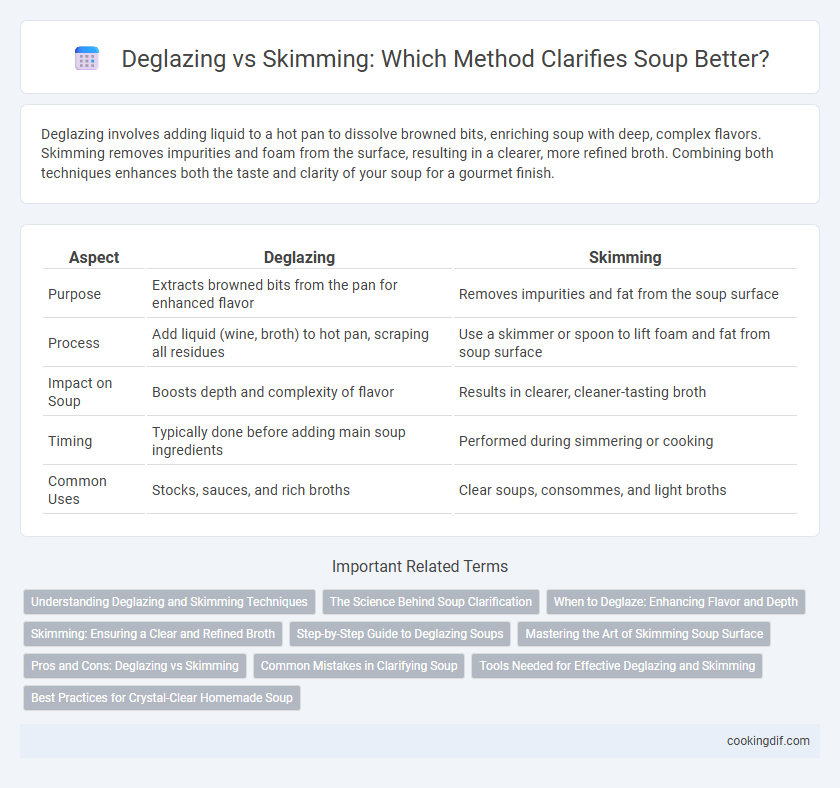Deglazing involves adding liquid to a hot pan to dissolve browned bits, enriching soup with deep, complex flavors. Skimming removes impurities and foam from the surface, resulting in a clearer, more refined broth. Combining both techniques enhances both the taste and clarity of your soup for a gourmet finish.
Table of Comparison
| Aspect | Deglazing | Skimming |
|---|---|---|
| Purpose | Extracts browned bits from the pan for enhanced flavor | Removes impurities and fat from the soup surface |
| Process | Add liquid (wine, broth) to hot pan, scraping all residues | Use a skimmer or spoon to lift foam and fat from soup surface |
| Impact on Soup | Boosts depth and complexity of flavor | Results in clearer, cleaner-tasting broth |
| Timing | Typically done before adding main soup ingredients | Performed during simmering or cooking |
| Common Uses | Stocks, sauces, and rich broths | Clear soups, consommes, and light broths |
Understanding Deglazing and Skimming Techniques
Deglazing involves adding liquid, such as broth or wine, to a hot pan to dissolve browned food residues, enhancing soup's depth of flavor and richness. Skimming removes impurities and fat from the soup's surface, resulting in a clearer and cleaner broth. Mastering deglazing and skimming techniques improves both the taste and appearance of soups, creating a balanced and refined dish.
The Science Behind Soup Clarification
Deglazing involves adding a liquid, often wine or stock, to a hot pan to dissolve browned food particles, enhancing soup flavor and contributing to clarity by incorporating these flavorful bits. Skimming removes impurities such as fat, foam, and coagulated proteins from the surface of the soup, preventing cloudiness and promoting a clear broth. Both techniques leverage the separation of solids and liquids at different stages, relying on temperature and solubility principles to achieve a clarified, visually appealing soup.
When to Deglaze: Enhancing Flavor and Depth
Deglazing is essential when developing soup bases that require deep, caramelized flavors from browned bits stuck to the pan after sauteing vegetables or meat. This technique involves adding liquid such as stock, wine, or water to dissolve fond, enriching the soup with intense umami and complexity. Skimming, in contrast, is used later to remove impurities and excess fat, ensuring a clear broth without sacrificing the depth created during deglazing.
Skimming: Ensuring a Clear and Refined Broth
Skimming is essential for clarifying soup by removing impurities and excess fat that rise to the surface during cooking, resulting in a clear and refined broth. This technique enhances the visual appeal and flavor of the soup by preventing cloudiness and off-tastes caused by scum and fat residues. Proper skimming ensures a clean, transparent stock ideal for consommes and delicate soups, preserving their purity and depth of flavor.
Step-by-Step Guide to Deglazing Soups
Deglazing soups involves adding a liquid, such as broth or wine, to the pot after sauteing ingredients, scraping the browned bits (fond) from the bottom to enhance flavor and depth. The step-by-step process includes heating the pot, pouring in the deglazing liquid, stirring to dissolve the fond, then incorporating the liquid back into the soup base. Skimming, by contrast, removes impurities and fat from the surface to clarify the soup, but deglazing focuses on flavor extraction and enrichment.
Mastering the Art of Skimming Soup Surface
Skimming involves gently removing impurities and fat from the surface of soup to achieve clear, flavorful broth, whereas deglazing is the process of dissolving browned food residues from a pan to enrich the soup's base. Mastering the art of skimming requires using a fine mesh skimmer or ladle to capture scum without disturbing the soup, resulting in a pristine, clarified liquid. Proper skimming enhances the soup's texture and visual appeal, essential for consommes and delicate broths.
Pros and Cons: Deglazing vs Skimming
Deglazing enhances soup flavor by dissolving browned bits from the pan, adding depth and richness, but it may introduce extra fat or strong flavors that overpower delicate soups. Skimming removes impurities and excess fat, resulting in a clearer, lighter broth, though it can also strip some flavor compounds essential for a robust taste. Choosing deglazing versus skimming depends on the desired soup clarity and flavor intensity, with deglazing better for hearty soups and skimming ideal for refined, clean-tasting broths.
Common Mistakes in Clarifying Soup
Common mistakes in clarifying soup include confusing deglazing and skimming; deglazing involves adding liquid to dissolve browned bits from the pot for flavor, while skimming removes impurities like foam and fat from the surface. Overlooking skimming can result in cloudy broth, while improper deglazing may introduce unwanted bitterness. Proper clarification demands continuous skimming and careful deglazing to achieve a clear, flavorful soup.
Tools Needed for Effective Deglazing and Skimming
Effective deglazing requires tools like a wooden spoon or heat-resistant spatula to gently scrape browned bits from the pan, enhancing soup flavor. Skimming demands a fine mesh skimmer or ladle to remove impurities and fat from the broth's surface, ensuring clarity. Using these specialized tools improves the soup's taste and visual appeal by maximizing flavor extraction and achieving a clean, clear broth.
Best Practices for Crystal-Clear Homemade Soup
Deglazing involves adding liquid to a hot pan to dissolve browned food residues, enriching soup flavor while aiding clarity by incorporating these caramelized bits. Skimming removes impurities and foam from the surface during simmering, preventing cloudiness and resulting in a clean, transparent broth. Combining deglazing with regular skimming ensures a crystal-clear homemade soup by maximizing flavor extraction and minimizing suspended particles.
Deglazing vs Skimming for clarification Infographic

 cookingdif.com
cookingdif.com